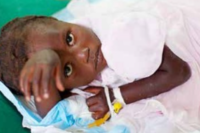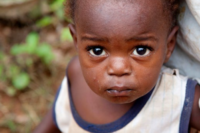Anthony Karabanow, MD
For decades, Haiti had the highest incidence of human rabies of all Latin American and Caribbean countries.1 In 2005, a human case in Florida was acquired from a rabid dog exposure in Haiti.2 As of 2006, Haiti reported 11 of 29 dog-related human cases in the Americas. With enhanced national vaccination of nearly 200,000 dogs and control efforts, the number of reported human cases fell to five deaths in 2007.3 According to the CDC website, preliminary surveillance assessments from January to May 2010, based upon clinical signs alone, suggest as many as 17 possible human rabies cases.
Rabies is a viral illness transmitted by the bite of an infected animal. In Haiti, the main animal source is the dog. Indeed, any dog bite in Haiti is to be considered to be a potential source of rabies until proven otherwise. Rabies diagnostic tests are unavailable in Haiti.
The virus is deposited in wounds from the saliva of an infected animal. It then enters local nerves where it migrates towards the spinal cord at a rate of 50 to 100 mm per day. Once the virus reaches the spinal cord, it rapidly ascends to reach the brain. At this point there is massive viral replication and dissemination of the virus throughout the nervous system. The salivary glands are richly supplied by nerves. Thus, this is a site of high viral load. The incubation period of the virus is one to three months. The first signs of rabies are a non-specific flu like illness which lasts several days. Then the classic signs of rabies appear. Ultimately, the patient lapses into a coma and dies of respiratory failure and shock.
The classic syndrome of rabies is actually one of two clinical forms. This is “encephalitic” or “furious” rabies. This form is characterized by excessive salivation, hyperactivity, fever and a fluctuating level of consciousness. Most patients also demonstrate aerophobia (fear of drafts) and hydrophobia (fear of drinking water) as these typically provoke painful pharyngeal (throat) spasms. A less well known (and less prevalent) rabies syndrome is that of “paralytic” or “dumb” rabies. This results in various forms of paralysis.
It is important to understand that rabies is 100% fatal. Thus preventative care is absolutely essential.
The WHO divides contact with potentially rabid animals into 3 categories:

If the attacking animal can be captured, it should be observed for a period of 10 days. If after 10 days, the animal shows no signs of rabies, post-exposure prophylaxis may be discontinued. The initiation of post-exposure prophylaxis should NEVER be delayed in order to observe the attacking animal.
Prevention of rabies consists of the following:
1) Pre-exposure vaccination: This consists of 3 doses of vaccine on days 0, 7 and 21. This is not mandatory for travelers to Haiti unless significant animal contact is anticipated. Moreover, it is quite expensive.
2) Wound care: Wound cleansing reduced the chance of acquiring rabies by as much as 90%. Use of soap and water is adequate. However, povidone-iodine is ideal as this agent kills the rabies virus.
3) Post-exposure measures: If the patient has not received pre-exposure vaccination, rabies immune globulin treatment is essential (for category III wounds.) This is not readily available but may be obtained from Port au Prince. This is not necessary if the patient received pre-exposure vaccination. Thus, this is the major advantage of investing in such vaccination. The dose is 20 IU/kg of human rabies immunoglobulin. Ideally, as much as possible of the dose is injected into the area in and around the wound. The remainder is given intramuscularly. Both those who received and those who did not receive pre-exposure immunization must receive several more doses of the rabies vaccine after a bite:
– days 0, 3, 7, 14, 28 (unvaccinated persons)
– days 0, 3 (vaccinated persons)
The US Advisory Committee on Immunization Practices has eliminated the day 28 vaccine as of 2010 but would not distinguish between category II and III wounds (i.e. all bites receive immune globulin.)
Vaccine doses should be given in the deltoid (shoulder) and never into the gluteal region where they are less effective. Vaccine and immune globulin should be given at different sites to avoid cross-neutralization.
The goal of rabies care is the aggressive treatment of any potential rabid bite. In Haiti, this means any dog bite unless the dog is definitively known to be free of rabies. Ideally such care is delivered ASAP after a bite. However, unless clinical symptoms have developed, it is never too late to initiate such care. Once clinical symptoms develop, rabies is invariably fatal.
References:
1. Schneider MC, Belotto A, Adé MP, Hendrickx S, Leanes LF, Rodrigues MJ, Medina G, Correa E. Current status of human rabies transmitted by dogs in Latin America.Cad Saude Publica. 2007;23:2049-63.
2. Blanton JD, Robertson K, Palmer D, Rupprecht CE. Rabies surveillance in the United States during 2008. J Am Vet Med Assoc. 2009;235:676-89.
3. PAHO Today. The Newsletter of the Pan American Health Organization. July, 2008. Washington, D.C.









